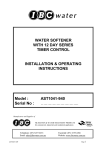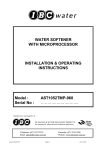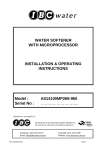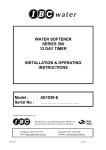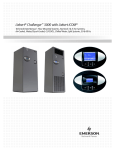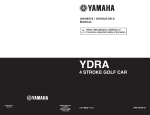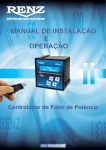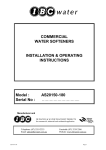Download AS0715-940 - IBC Water
Transcript
WATER SOFTENER WITH 12 DAY SERIES TIMER CONTROL INSTALLATION & OPERATING INSTRUCTIONS Model : Serial No : AS0715-940 ……………………….. Manufacturer and Supplier of FILTRATION & WATER TREATMENT PRODUCTS for commercial, industrial and residential application Telephone: (07) 3219 2233 Email: [email protected] AS0715-940 Facsimile: (07) 3219 2266 Website: www.ibcwater.com.au Page 1 HARDNESS TEST 1. Water to be tested should be taken from a tap after the water softener 2. Measure 10ml of water into plastic bottle supplied (approximately 1/3 full) 3. Add one Yes/No tablet to sample water, replace cap and shake until tablet has completely dissolved. (NOTE: do not handle Yes/No tablet with fingers) 4. The final colour to be obtained for soft water is green. (Note: The shade of green may vary.) If the colour turns red, the water is above 20 mg/l hardness, therefore another regeneration is recommended. 5. Rinse plastic bottle after each test has been completed. 6. When used as above, the tablets change the colour from green to red at a hardness of approximately 20ppm based on a sample volume of 10mls. Other hardness test kits are available for more accurate testing eg. Hardness Tablets Directions: Take a 50ml sample of water in a screw capped bottle. Add one (1) tablet to sample, shake or crush to disintegrate. Repeat until last trace of reddish tinge disappears. The final colour is usually blue but with some water a greyish coloured end point is obtained. Using 50ml sample Hardness ppm = (number of tablets x 40) - 20 LR (BW) Tablets Directions: Take a 100ml sample of water in a screw capped bottle. Add one (1) tablet to sample, shake or crush to disintegrate. Repeat until last trace of reddish tinge disappears. The final colour is usually blue but with some water a greyish coloured end point is obtained. Using 100ml sample Hardness ppm = (number tablets x 2) – 1 Contact IBC Water if further details are required. AS0715-940 Page 2 WATER SOFTENER CALCULATIONS MODEL AS0715-940 To ascertain DAYS between regeneration periods the following data or estimations are required. (Let N be the number of days to be calculated) .1. ð Water Hardness in mg/l .2. ð Water Softener Hardness Removal Capacity from Table 1 in grams call ð call ð .3. call ð H C Daily Water Usage in litres ð D For household situations allow 250 litres per person per day. CALCULATION N = 1000 x C DxH Select nearest lower whole number If necessary consult your dealer or IBC Water Treatment for advice on setting up the softener. EXAMPLE Household use for 2 people on 220 mg/l hard water using Model AS0715 at 1050 grams capacity. N = 1000 x 1050 500 x 220 = 9.5 days = 9 days Note: Maximum number of days that can be selected is twelve (12). AS0715-940 Page 3 WATER SOFTENER PERFORMANCE DATA SHEET Automatic Model No. AS0715-940 Capacity & Salt Dosage Minimum Maximum gram/kg gram/kg 525/1 1050/3.6 Recommended Maximum Service Flow Rate Pipe Size Resin Volume Approx. Shipping Weight (kg) Space Required Inlet Outlet Drain Flow LPM mm mm Litres Per Kg metres 15 25 12 15 27 0.70 0.50 1.2 WxDxH CABINET/BRINE CHAMBER: POLY MOULDED Operating Pressure: 140 - 690 kPa Temperature: 5o x 50oC Electrical: 240V 50Hz 3 watts maximum WARNING A pressure reduction valve should be installed in areas of high water pressure (above 690kPa) A water hammer arrestor should be installed if water hammer prevails. Caution: Do not use where water is microbiologically unsafe or with water of unknown quality. FAILURE TO OBSERVE WARNINGS WILL VOID WARRANTY AS0715-940 Page 4 INSTALLATION OF IBC CABINET WATER SOFTENER UNIT FITTED WITH MODEL 255 VALVE/940 CONTROL Check the equipment upon arrival for damage or shortages and report same to our Office or Agent before starting. Position the Softener Cabinet on a firm foundation, preferably concrete, with sufficient space for operation and maintenance. STEP 1 Connect inlet, outlet pipes and drain line to control valve as per Instruction Booklet (page 5, figure 3). Note: The softener is supplied with the Autotrol Series 156 Bypass Valve as standard. STEP 2 Remove lid from brine tank. Then connect brine overflow drain line to waste trap. STEP 3 Refer to Instruction Booklet for start up procedure (page 6 “Placing conditioner into Service”). STEP 4 Load recommended quantity of water softener salt into brine tank and replace lid (refer to Table 3 “Brine Tank Salt Loading”). Table 3 MODEL AS0715-940 AS0715-940 RESIN LITRES BRINE TANK - SALT LOADING KG 15 50 Page 5 ASSEMBLE TOP STRAINER TO VALVE BODY PUSH AND TWIST INTERNAL RISER PIPE NOTE: ON A NUMBER OF SOFTENER MODELS AND FILTERS IT IS NECESSARY TO PACKAGE THE VALVE WITH THE TOP STRAINER SUPPLIED LOOSE. IT IS IMPORTANT THAT THIS STRAINER IS ASSEMBLED TO THE VALVE DURING INSTALLATION. THE LENGTH OF THE INTERNAL RISER PIPE IS FACTORY ADJUSTED FOR THE TANK SIZE PROVIDED. DO NOT SHORTEN THIS PIPE UNDER ANY CIRCUMSTANCES AS0715-940 Page 6 940I Low Voltage Timer Control The softener Control fitted is powered by a 240 to 12 Volt Transformer. The Transformer plugs into a 10amp 240volt GPO and the transformer lead plugs into a socket located on the back of the timer at the left-hand side. The Transformer is only suitable for indoor mounting. Indicator Knob Salt Dial Clock Dial Day Pins (Do not rotate by hand) Calendar Cap Low Voltage Transformer Only use the included transformer for powering the Timer. Connect the plug of the transformer cable to the mating socket at the rear of the Timer housing on the left-hand side. When ordering spare parts: - Advise that the Timer is the low voltage model AS0715-940 Page 7 Series 255 Valve / 940 Control Water Conditioning Control System Installation, Operating and Maintenance Manual AS0715-940 Page 8 Table of Contents Page Introduction ……………………………………………………………… 10 Superior Design Superior Operation Installation ……………………………………………………………….. 10 Location Selection Water Line Connection Drain Line Connection Brine Line Connection Brine Tank Overflow Line Connection Electrical Connection Placing Conditioner into Operation …………………………………. 13 Adjustment of Timer ……………………………………………………. 14 Special Features of Timer Adjustment of Brine Control ………………………………………….. 14 How to Set the Salt Dial Service ……………………………………………………………………. 15 Removing the Timer Assembly Removing the Valve Assembly Preventative Maintenance …………………………………………..… 17 Injector Screen and Injector Specifications …………………………………………………….……... 18 Pressure Graphs ……………………………………………………..…. 19 Control Valving identification…………………………………………. 20 Valve Disc Operation ………………………………………….……….. 20 Flow Diagrams …………………………………………………………... 21 Replacement Parts ……………………………………………………... 22 Trouble Shooting …………………………………………………….…. 26 Disinfection of Water Conditioners………………………………….. 27 AS0715-940 Page 9 Introduction • Direct acting system functions independently of water pressure. No pistons or diaphragms that require a minimum water pressure to operate. • Five-cycle operation provides for down flow service, up flow backwash, down flow brining, down flow slow and fast rinse. A sixth position is included for timed refill of the brine tank. • Valve discs are held closed by water pressure and therefore, are leak tight. The sealing forces are increased as the water pressure is increased. Valve seats are in a vertical position, which is design position least vulnerable to plugging. • System operation cannot get out of phase or sequence. The control always returns to a fixed service position of regeneration regardless of where in the regeneration cycle it was started. • Bypass (unconditioned) water is automatically available during regeneration. Thank you for purchasing a water conditioner system featuring the Series 255 with a model 940 Control. The Model 940 Control provides dependable time clock based operation. The Series 255 valve combines simplicity with reinforced NORYL * construction to provide an uncommonly reliable appliance. The inherent quality of the system means a long life of efficient, trouble-free soft water. If maintenance becomes necessary, the Series 255/940 Control offers a unique separation capability illustrated in the Service section of this manual. Superior design • Single synchronous electric motor provides all the power for the clock and the operation of the control. • Electrical wiring is factory assembled. System cannot be connected incorrectly. • Program clock 940 (timer) and 960 Demand system are interchangeable. Both units provide guest regeneration capability. • • System may be indexed manually with or without power to any one of its service or regeneration positions. Legend on timer faceplate indicates control valve position. No moving parts in water stream means no close tolerance parts subject to fouling. Thus, the system is especially effective on iron-bearing water. • No dynamic seals that could cause leakage through wear or fatigue. • Control accepts NORYL* or brass manifold or modular bypass valve without modification, offering complete versatility and easy plumbing for any installation. • Brining control valve built into system eliminates need for any brine valve. • Drain flow control is built into the valve to control backwash and fast rinse flow rates. • NORYL is a trademark of GE Plastics. Superior Operation AS0715-940 Installation All plumbing and electrical connections must conform to local codes. Inspect the unit carefully for carrier shortage or shipping damage. Location Selection • • • Locate unit as close to a drain as possible If supplementary water treating equipment is required, make sure that adequate additional space is available. Locate the brine tank in an accessible place so that salt can easily be added. Do not install any unit closer than 10ft (3m) of piping between the outlet of the water conditioner and the inlet of the water heater. Water heaters can transmit heat back down the cold water pipe into the control valve. Hot water can severely damage the controller. A 10ft (3m) total pipe run (including bends, elbows etc) is a reasonable distance to prevent hot water damage. A positive way to prevent hot water from flowing from a heat source to the conditioner is to install a check valve in the soft water piping from the conditioner. If a check valve is installed, make sure that the water-heating unit is equipped with a properly rated temperature and pressure safety relief valve. Always conform to local codes. • • • Do not locate the unit in an area where the temp ever falls below 34ºF (1ºC) or over 120ºF (49ºC). Do not install the unit near acid or acid fumes. Do not expose the unit to petroleum products. Page 10 Figure 1 - Control Bypass Valve (optional) Air Check Brine Tube Fitting Connection 1/4" Inlet Connection 3/4" or 1" NPT or BSPT Drain Connection 3/8" or 1/2" NPT or BSPT Outlet Connection 3/4" or 1" NPT or Tank Tread 2-1/2" - 8 male NPSM Figure 2 - Tank Adaptor AS0715-940 Page 11 Water Line Connection A bypass valve system must be installed to provide for occasions when the water conditioner must is bypassed for hard water or for servicing. The most common bypass systems are the Autotrol Series 156 Bypass Valve, Figure 3, and plumbed-in globe valves, Figure 4. Though both are similar in function, the Autotrol Bypass offers simplicity and ease of operation. Not In Bypass In Bypass Figure 3 - Autotrol Series 156 Bypass Valve Not In Bypass In Bypass Figure 5 - Air Gap Installation Caution Never connect the drain line into a drain, sewer line or trap. Always allow an air gap between the drain line and the wastewater to prevent the possibility of sewage being back-siphoned into the conditioner. The ideal location for the unit is above and not more than 20ft (6.1m) from the drain. For such installations, using the appropriate adaptor fitting (not supplied), connect 1/2 in (1.3cm) plastic tubing to the drain line connection located at the rear of the control. If the unit is located more than 20ft (6.1m) from the drain, use 3/4in (1.9cm) tubing for runs up to 40ft (12.2m). You may elevate the line up to 6ft (1.8m) providing the run does not exceed 15ft (4.6m) and the water pressure at the conditioner is not less than 40psi (280kPa). You may elevate an additional 2ft (61cm) for each additional 10psi (70kPa) of water pressure. When the drain line is elevated and empties into a drain which is below the level of the control valve, form a 7 inch (17cm) loop at the drain end of the line so that the bottom of the loop is level with the drain line connection. This provides an adequate siphon trap. If the drain empties into an overhead sewer line, a sink-type trap must be used. Note: The above instructions reflect standard commercial practices. Local codes may require different installation procedures. Brine Line Connection Install the brine tube and connect to the fitting connection located on the air check on the tank adaptor module, see Figure 2. Figure 4 - Typical Globe Valve Bypass System Drain Line Connection The drain line discharges water and brine during the regeneration cycles. Typically, the line drains into a floor drain or laundry tube. Plumb the drain line according to local codes, leaving a one or two inch air gap between the end of the drain line and the opening, Figure 5. AS0715-940 Note: Make sure that all fittings and connections are tight so that premature checking does not take place. Premature checking occurs when the ball in the air check falls to the bottom before all brine is drawn out of the brine tank. Refer to the Troubleshooting section in this manual for additional information. Brine Tank Overflow Line Connection In the event of a malfunction, the tank overflow connection directs overflow to the drain instead of spilling on the floor where it could cause water damage. Complete the following steps to connect the overflow fitting to the brine tank: 1. Locate the fitting hole on the side of the brine tank. Page 12 2. Insert the overflow fitting (not supplied) into the tank and tighten with the plastic thumbnut and gasket as illustrated in Figure 6. 3. Attache a length of 1/2in (1.3cm) tubing (not supplied) to the fitting and run to the drain. Note: Don not elevate the overflow line higher than 3in (7.6cm) below the bottom of the overflow fitting. Do not tie into the drain line of the control unit. The overflow line must be a direct, separate line from the overflow fitting to the drain, sewer or tube. Allow an air gap as in the drain line connection, Figure 5. If the water supply valve is opened too rapidly or too far, resin may be lost. In the BACKWASH position, you should hear air escaping slowly from the drain line. 3. When all the air is purged from the tank (water begins to flow steadily from the drain), slowly open the main supply valve all the way. Allow the water to run into the drain until the water appears clear. Turn off the water supply and wait for about five minutes to allow all trapped air to escape from the tank. 4. Add water to the brine tank (initial fill). With a bucket or hose, add approximately 4 gallons (15 litres) of water to the brine tank. Figure 6 - Overflow Line Connection Electrical Connection Remove the twist tie from the power cord and extend the cord to its full length. Make the power source matches the electrical rating of the control. Be sure the outlet you select is not controlled by a wall switch. Figure 7 Air Check Placing Conditioner into Operation After the water conditioning system is physically installed, we recommend that the conditioner be disinfected before it is used to treat potable water. Refer to the Disinfection of Water Conditioners section in this manual. Complete the following steps to place the conditioner into service. 1. Grasp the indicator knob on the timer (Figure 8) and rotate it counterclockwise about 45° to the back- wash position. You may find it helpful to remove the rear cover (Figure 10) and rotate the camshaft counterclockwise at the same time. 2. Fill the mineral tank with water by turning the water supply off and placing the bypass valve(s) into the "not in bypass" position. Open the water supply valve very slowly to approximately the 1/4 open position. Caution AS0715-940 5. To start up the unit: make sure the water supply valve is in the full open position. Carefully rotate the indicator knob, Figure 8, counterclockwise until the indicator points directly to the centre of the REFILL position and hold there until the air check (Figure 7), fills with water and water flows through the brine line into the brine tank. Do not run the water into the brine tank for more than one or two minutes. Rotate the indicator knob counterclockwise until the indicator points to the centre of the BRINE/ SLOW RINSE position. Check the water is being drawn from the brine tank. The water level in the brine tank will recede very slowly. Observe the water level for at least three minutes. If the water level does not recede, if it goes up, or if air enters the air check sight glass and the ball falls and seats, refer to the Troubleshooting section in this manual. Page 13 Finally, rotate the indicator knob counterclockwise until the indicator points to REGENERATION COMPLETE. Run water from a nearby cold-water faucet until the water is clear and soft. Adjustment of Timer Salt Dial Indicator Knob Clock Dial Special Features of Timer Guest Cycle. When abnormally high water usage exhausts the water conditioner's capacity ahead of schedule, an extra regeneration can be achieved by turning the indicator knob counterclockwise to START, Figure 8. It will take a few minutes for regeneration to begin. The normal regeneration schedule will not be disrupted. Manual Regeneration. Electricity is used only to run the timer and to rotate the camshaft. All other functions are operated by water pressure. Therefore, in the event of a power outage, all the various regeneration positions may be dialled manually by rotating the indicator knob counterclockwise. Manual time cycle: BACKWASH……………………..14 minutes BRINE AND SLOW RINSE……. 52 minutes FAST RINSE…………………….. 6 minutes REFILL…………………………… Read time Off Salt Dial Adjustment of Brine control Day Pins (Do not rotate by hand) Calendar Cap 1. Set days of regeneration (Figure 8). • Pull all day pins outward (away from control) • Depress day pin(s) at day(s) for which regeneration is desired. All models may be tuned to produce maximum to minimum conditioning capacities by adjusting the Salt Dial (Figure 9). The Salt Dial controls the amount of salt used per regeneration. When desired, the minimum setting may be used if the frequency of regeneration is increased to compensate for the lower regenerated conditioning capacity. Salt Dial Note: The NEXT DAY day pin is noted on the timer face. Depressing this pin will insure regeneration the next day at approximately 2:00am. Since the calendar cap progresses clockwise, depressing the day pin immediately counterclockwise will insure regeneration the following day at 2:00 am. This progression is noted on the timer face as "FUTURE DAYS". 2. Set the time of day. • Rotate Clock Dial until the pointer is directed at the current time. Note: With the time of day properly set, the conditioner will regenerate at about 2:00 am. If you prefer to have the unit regenerate at an earlier or later time, simply set the current time-of-day accordingly. (e.g., To have the unit REGENERATE at 4:00am - 2 hours later - set the clock 2 hours later than the actual time). Note: Do not rotate the Calendar Cap by hand; the clock dial indexes it daily. To manually index the Calendar Cap, rotate the Clock Dial clockwise one complete turn for every day to be indexed. AS0715-940 Indicator Knob How to Set the Salt Dial With the indicator knob in the REGENERATION COM-PLETE position (Figure 8), rotate the Salt Dial counter-clockwise at least one full turn to cancel out the previous setting. A light clicking will be replaced by a heavier clicking when the previous setting is cancelled. Then, rotate the Salt Dial to the proper salt setting. The numbers on the dial are "minutes" of water flow to the brine tank. When using the .4 gpm Brine Refill Control, each minute corresponds to 1.2 pounds of salt. The size of the brine control is embossed on the refill cap. The embossed number corresponds to the gpm flow control. Example: 33 corresponds to .33 Page 14 gpm flow control. One gallon of water will dissolve 3.0 pounds of salt. Figure 10 To calculate the time for brine refill, it is necessary to determine the needed pounds of salt and divide that number by three (3 pounds per gallon) and also divide by the flow control gpm. The result is the time setting in minutes for brine refill. Be sure to round off times to the nearest minute Reference Table 1 for common settings. MODEL AS0715-940 WATER SOFTENER HARDNESS REMOVAL CAPACITY INGRAMS SALT USAGE IN KILOGRAMS SALT DIAL SETTING TIME IN MINUTES 525 (MIN) 1.0 3 700 1.6 4 825 2.2 6 1050 (MAX) 3.6 9 NOTE: - THIS SOFTENER IS FITTED WITH THE 0.33 G.P.M BRINE REFILL CONTROL Service Removing the Timer Assembly Complete the following steps to remove the timer assembly for servicing: 1. Unplug the power cord. 2. Remove the rear cover by pushing back on the tab provided on the cover with your thumb, Figure 10. Next, lift the cover off the valve. AS0715-940 3. To remove the camshaft (or reinstall it), the rib on the shaft must be pointing straight up. This occurs when the indicator knob is rotated to the refill position. Press down on the back of the camshaft to disengage it from the rear "hoop" of the top plate, Figure 11. Page 15 6. To replace the timer, reverse the above Procedure. Figure 11 4. Slide the camshaft back, disengage it from the timer, Figure 12. Note: The camshaft and the timer indicator knob need to be positioned correctly before the camshaft can be installed. Rotate the camshaft such that the locating rib is pointing straight up. The timer indicator knob must be in the REFILL position when installing the camshaft. Slide the camshaft into the timer. It may be necessary to rock the timer slightly to key the camshaft into the timer. When the camshaft is slid into place, lift he back of the camshaft up while rotating the indicator knob to seat the camshaft in the top plate "hoop". Removing the Valve Assembly Complete the following steps to remove the valve assembly: 1. Unplug the power cord. 2. Shut off the water supply or place in bypass 3. Relieve the system pressure by opening the rinse drain valve (the fifth valve back from the timer) with a screwdriver, Figure 14. Figure 12 5. Lift the timer off the valve, Figure 13. Figure 14 4. Remove the locking bar screw, Figure 15. Figure 13 AS0715-940 Page 16 require more frequent injector and screen servicing. Refer to Figure 17 and complete the following steps to clean the injector screen and injector: 1. Unplug the power cord. 2. Shut off the water supply or put the bypassvalve(s) into the bypass position and remove the rear cover, Figure 10. Figure 15 3. Relieve system pressure by opening the rinse drain valve (the fifth valve back from the control) with a screwdriver, Figure 11. 4. Using a blade screwdriver, unscrew and remove the injector screen and injector cap. 5. Apply downward hand pressure on the valve and remove the locking bar, Figure 16. 5. Clean screen with a fine brush. Flush with water until clean. 6. Using a needle-nose pliers, pull the injector straight out. 7. Flush water into the injector screen recess of the valve body to flush debris out through the injector recess. 8. Clean and flush the injector. Lubricate the o-rings on the injector, injector cap and injector screen with silicone lubricant. Figure 16 6. Using the rocking motion, lift the valve from the tank adaptor, Figure 16. If the o-ring seals come off with the valve put them back into the tank adaptor sockets. Lubricate the o-rings with silicone lubricant. Note: Petroleum based lubricants will damage the Plastic valve and o-rings. Reverse the procedure to replace the valves. Figure 17 Preventative Maintenance Injector Screen and Injector The injector is the component which creates the vacuum necessary to draw the brine into the water conditioner. Clean the injector and injector screen at least once a year in order to maintain proper operation of the conditioner. Some locations may AS0715-940 9. Reinstall the injector (small and first), injector cap and injector screen. Caution Do not overtighten the plastic cap. Seat he Page 17 cap lightly into position. Overtightening can cause breakage of the plastic cap which may not be evident immediately 11. Reconnect electric power, and reset the time of day. 10. Slowly open the water supply valve or return the bypass valve(s) to the not in bypass" position. Hydrostatic Test Pressure ……………………………………………………………………………. 300 psi (2069kPa) Working Pressure ………………………………………….. 20 to 127 psi (138 to 876 kPa), 100 psi max in Canada Voltage ……………………………….. 24V 50 Hz, 24V 60 Hz, 100V 50 Hz, 100V 60 Hz, 230V 50 Hz, 115V 60 Hz Current ……………………………………………………………………………………………………………….. 50 mA Operating Temperature …………………………………………………………………..… 34°F (1°C) to 120°F (49°C) Humidity ………………………………………………………………...…………….10% to 100%, condensing allowed Pressure Tank Thread ………………………………………………………………………………… 2 1/2 in - 8 NPSM Brine Line Thread ………………………………………………………………………………………... 1/4 in NPT male Distributor Tube Diameter Required …………………………………………………………. 13/16 in O.D. (20.6 mm) AS0715-940 Page 18 Distributor Tube Length …………………………………………... 1 1/4 in (31.8mm) higher than top of mineral tank Standard Manifold Connection ……………………… 3/4 in NPT inlet-outlet, 1/2 in NPT drain in NORYL manifold, 3/8 in NPT drain in brass manifold Optional Manifold Connections …………… 1 in NPT inlet-outlet, 1/2 in NPT drain; 3/4 in BSPT inlet-outlet, 3/8 in BSPT drain; 1 in BSPT inlet-outlet, 1/2 in. BSPT drain Optional Bypass Valve ……………….. 3/4 in (19.1mm) or 1 in (25.4mm) copper tailpiece, 1/2 in NPT male drain Valve Module, Tank Adaptor, Optional Bypass Valve …………………………………………… Reinforced NORYL Inlet-Outlet Manifold ………………………………………………………………………... Brass or reinforced NORYL Rubber Parts ………………………………………………………………………. Compounded for cold water service Injector size "A" White …………………… Nozzle 0.042 in (1.1 mm) diameter, Throat 0.089 in (2.3 mm) diameter Injector size "B" Blue …………………….. Nozzle 0.052 in (1.3 mm) diameter, Throat 0.099 in (2.5 mm) diameter Injector size "C" Red …………………… Nozzle 0.059 in (1.51 mm) diameter, Throat 0.099 in (2.5 mm) diameter Backwash Controllers Available for ………………………………………………………... 6, 7, 8, 9, 10, 12, 13, 14 in (15.2, 17.8, 20.3, 22.9, 25.4, 30.5, 33.0, 35.6 cm) diameter mineral tanks All sized to flow 4.5 gpm/sq ft (183 l/min/m2) of bed area Pressure Graphs AS0715-940 Page 19 Control Valving Identification AS0715-940 Valve Disc Operation Page 20 Flow Diagrams AS0715-940 Page 21 AS0715-940 Page 22 Replacement Parts 940 Timer Code Part No. Description Qty 1 1000855 Backplate 1 2 1000879 Gear Support Plate, 12 - Hour Clock 1 3 1000881 Timer Cover, English Standard 1 4 1000887 7 - Day Calendar Cap Assembly 1 5 1000888 12 - day Calendar Cap Assembly 1 6 1000877 Main Drive Stack 1 7 1000848 Knob 1 8 1000857 Salt Dial 1 9 1000847 Salt Gear 1 10 Main Drive Gear 1 Standard Cycle Water Saver, Economy Cycle Extra Salt & Long Rinse, Long Rinse Cycle Adj. Backwash/Standard Cycle Adj. Backwash/Extra Salt Long Rinse, Long Cycle 1000905 3 Cycle/Adj. Backwash Code Part No. Description Qty 12 1000841 Clutch Gear 1 13 1007483 Wire Nut 1 14 1000833 Gear 1 15 1000832 Gear 1 16 1000858 Geneva/Clock 1 17 1000844 Geneva/Drive Gear 1 18 Power Cord 1 1000821 North America (Flat 2-Wire) 1007495 Italy (CEI 23-16/VII) 25A292 Continental Europe (CEE 7/7) 25A303 United Kingdom (AS 3112) 1007496 Australia (AS 3112) 25A555-001Japan (JIS 8303) 1000822 Lamp Cord, Low Voltage (24V) 25A394 North America (US - NEMA 5-15P) (Canada C22.2 No. 42) (Flat 3-Wire) * 1000939 Retainer, Calendar Cap ( *Not Shown) 1000900 1000901 1000902 1000903 1000904 11 1000802 1000803 1000804 1000805 1000806 1000807 AS0715-940 Motor Option 24V 50 Hz 24V 60 Hz 110V 50 Hz 100V 60 Hz 230V 50 Hz 115V 60 Hz 1 Page 23 AS0715-940 Page 24 Valve Body and Tank Adaptor Module AS0715-940 Page 25 Code Part No. Description 1 1000238 Valve Assy. w/o Flow Controls 1 2 1000824 Camshaft, Std, One-Piece 1 3 1000827 Valve Cover, Black 1 4 Brine Refill Flow Control Assy. : 1000221 .14 GPM 1000222 .33 GPM 1000223 .40 GPM 1 5 1000226 Screen/Cap Assy. With O-ring 1 6 Backwash Control Assy. With O-rings: No. 7 for 7 in Diameter Tank No. 8 for 8 in Diameter Tank No. 9 for 9 in Diameter Tank No. 10 for 10 in Diameter Tank No. 12 for 12 in Diameter Tank No. 13 for 13 in Diameter Tank No. 14 for 14 in Diameter Tank 1 1000209 1000210 1000211 1000212 1000213 1000214 1000215 Qty Part No. Description Qty 10 1033784 Tank Adaptor Assy. 1 11 1032416 Air Check Ass. 1 12 1010429 O-ring, 3-1/8x3-1/2x3/16 BN 1 13 1010428 O-ring, 3/4x1x1/8 EP 1 14 Locking Bar: 1031402 English Language 1 15 1006093 Screw, No. 8x9/16 in1 16 1001580 Spring, Valve Discs 17 * 7 1030502 Ball, Flow Control 1 8 Injector Assy. With O-rings 1032970 "A" Injector - White 1032971 "B" Injector - Blue 1032972 "C" Injector - Red 1 9 Injector Cap With O-rings 1000217 "A" Cap 1000218 "B" Cap 1000219 "C" Cap 1 AS0715-940 Code 18 19 * 20 9 Kits: 1033066 New to Old Air Check Adaptor 1000250 Valve Discs Replacement (*Not Shown) 1001404 O-ring Group: Tank Adaptor 1040459 O-ring Group: Piping Boss 1000252 Severe Service Valve Discs (*Not Shown) 1041010 Optional Riser Insert 13/16 Page 26 Bypass Valve and Piping Boss Code Part No. Description Qty 1 1040769 Bypass Body Assy 1 2 1040524 Installation Kit: 3 1001606 1001670 1001608 1001609 1001613 1001614 1001615 1001769 1001603 1001604 1001605 1001611 1001610 1001612 Code Part No. Description Qty Piping Boss AS0715-940 3/4 in Copper Tube Adaptor Kit 1 1 in Copper Tube Adaptor Kit 22mm Copper Tube Adaptor Kit 28mmCopper Tube Adaptor Kit 1 3/4 in CPVC Tube Adaptor Kit 1 in CPVC Tube Adaptor Kit 25mm CPVC Tube Adaptor Kit 1 3/4 in NPT Plastics Pipe Kit 1 in NPT Plastics Pipe Kit 3/4 in BSPT Plastic Pipe Adaptor Kit 1 in BSPT Plastic Pipe Adaptor Kit 3/4 in BSPT Brass Pipe Adaptor Kit 1 in NPT Brass Pipe Adaptor Kit 1 in BSPT Brass Pipe Adaptor Kit 4 Kit 1040277 1040278 1040281 1040282 1040279 1040280 1040283 1040284 5 1040339 Piping Boss Installation Kit 1 1 1 1 1 1 1 1 1 1 1 Piping Boss (Includes Hardware) 3/4 in NPT, Brass, 3/8 in NPT Drain 1 in NPT, Brass, 1/2 in NPT Drain 3/4 in BSPT, Brass, 3/8 in BSPT Drain 1 in BSPT, Brass, 1/2 in BSPT Drain 3/4 in NPT, Noryl, 1/2 in NPT Drain 1 in NPT, Noryl, 1/2 in NPT Drain 3/4 in BSPT, Noryl, 1/2 in BSPT Drain 1 in NPT, Noryl, 1/2 in NPT Drain Page 27 Troubleshooting The technology upon which the Series 255/940 control is based, is well established and proven in service over many years. However, should a problem or question arise regarding the operation of the system, the control can be very easily serviced. The control module can be quickly replaced or adjustments can be made at the installation. For parts mentioned, refer to exploded views in the Replacement Parts section of this manual. Problem IMPORTANT: Service procedures that require the water pressure to be removed from the system are marked with a ! after the possible cause. To remove water pressure from the system, put the bypass valve or three-valve bypass into the bypass position and open the Rinse Drain Valve (the fifth valve back from the control) with a screwdriver, Figure 11. Restore system water pressure when the service work is completed. Cause Solution 1. Control will not regenerate automatically a. Electric cord unplugged b. Defective Timer motor c. Day pins not down on calendar cap. d. Binding in gear train of timer a. Connect power b. Replace motor c. Depress pins for days regeneration required d. Replace timer 2. Control regenerates at Wrong time of day a. timer set incorrectly. a. Correct setting according to Instructions. 3. Control will not draw Brine. a. Low water pressure. a. Water pressure must be 20 psi minimum. b. Remove restriction. c. Clean injector and screen. d. Replace injector cap. e. Flush out foreign matter holding disc(s) open by manually operating valve stem(s). Replace if needed. f. Put control momentarily into brine refill. replace or repair air check if needed. Refer to Brine Line Connection. 4. Brine tank overflow. b. c. d. e. Restricted drain line. Injector plugged. ! Defective injector. ! Valve disc 2 and/or 3 not closed. f. Air check prematurely closed. a. Brine valve disc1 being held open By foreign matter. b. Uncontrolled brine refill flow rate. c. Valve disc 2 and/or 3 not closed During brine draw causing brine refill d. Air leak in brine line air check. e. Improper drain control for injector. 5. System using more or less salt than salt control Is set for. a. Inaccurate setting. b. Foreign matter in controller Causing incorrect flow rates. c. Defective controller. ! AS0715-940 a. Flush out foreign matter holding disc open by manually operating valve stem. b. Remove and clean brine refill flow control. c. Flush out foreign matter holding disc(s) open by manually operating valve stem(s). d. Check all connections in brine line for leaks. Refer to Brine Line Connection. e. Too small of a drain control with a "B" or "C" injector will reduce draw rates. Reference Pressure Graphs. a. Make correct setting b. Remove salt controller and flush out foreign matter. Manually position control to brine draw to clean controller. After so doing, position control to "brine/slow rinse" to remove brine from tank. c. Replace defective part. Page 28 AS0715-940 Page 29 6. Intermittent or irregular brine draw . a. Low water pressure. a. Water pressure must be 20 psi Minimum. b. Replace both injector and injector cap. b. Defective Injector. ! 7. No conditioned water After regeneration. a. Unit did not regenerate b. No salt in brine tank c. Plugged injector. d. Air check prematurely closed. a. Check for power. b. Add salt to brine tank. c. Remove injector and injector screen, Flush with water. d. Put control momentarily into brine refill To free air check. Replace or repair air check if needed. Refer to brine line connection. 8. Control backwashes at Excessively low or high Rate. a. Incorrect back wash controller. ! b. Foreign matter effecting controller Operation. ! a. Replace with correct size controller. b. Remove and clean controller seat and Ball. 9. Flowing or dripping Water at drain or brine Line after regeneration. a. Drain valve (5 or 6) or brine valve (1) held open by foreign matter or particle. b. Weak valve stem return spring on Top plate. a. Manually operate valve stem to flush Away obstruction. a. Improper regeneration. a. Repeat regeneration making certain Correct salt usage is used. b. Replace o-ring. c. Replace o-ring. d. Replace defective part. 10. Hard water leakage During service. b. Leaking external bypass valve. c. O-ring around riser tube Damaged. d. Leaking past bypass valve disc. b. Replace spring. Disinfection of Water Conditioners The construction materials of the water conditioner system do not support bacterial growth or contaminated the water supply. However, we recommend that the conditioners be disinfected after installation and before the conditioners are used to treat potable water. In addition, a conditioner can become fouled with organic matter during normal usage or with bacteria from the water supply. Periodic disinfection is recommended for all conditioners. Use one of the following methods of disinfection based on operating conditions, style of conditioner, type of ion exchange, and disinfectant available. Sodium Hypochlorite Sodium Hypochlorite, 5.25% solutions, can be used with polystyrene resin, synthetic gel zeolite, greensand, and bentonites and are available under trade names such as Chlorox, Linco, Bo Peep, White Sail and Eagle Brand Bleach. Adjust the dosage if stronger commercial solutions are used. The recommended dosage for 5.25% solution is: • Polystyrene resin: 1.2 fluid ounces per cubic foot. • Non-resinous exchangers: 0.8 fluid ounces per cubic foot. AS0715-940 Complete the following steps to disinfect the conditioner: Add the sodium hypochlorite solution to the brine well of the brine tank. Make sure that the brine tank has water init so the solution is carried into the conditioner. Proceed with normal regeneration. Refer to the Manual Regeneration section for this manual. Calcium Hypochlorite Calcium Hypochlorite, 70% available chlorine, is available in several forms including tablets and granules. These solid materials can be used directly without dissolving before application. The recommended dosage for Calcium Hypochlorite is two grains (approx. 0.1 ounce) per cubic foot. Complete the following steps to disinfect the conditioner: Add the Calcium Hypochlorite to the brine well of the brine tank. Make sure that he brine tank has water in it so the solution is carried into the conditioner. Proceed with normal regeneration. Refer to the Manual Regeneration section of this manual. Page 30






























